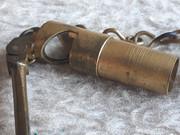What condition is the breech end of the barrel - that's the important bit for rifles that have fired cordite :
Reference to NC is 'Nitro Cellulose' (it is not referring to Non-Corrosive)
Use of Cordite in Rifles
'Regulations For Army Ordnance Services', Vol.3, Pam.11A (1949) comments:-
APPENDIX 15
USE OF .303-IN CORDITE AND N.C. AMMUNITION
1. The action of Cordite propellant in the barrel of a .303-in. weapon is quite different from that of N.C. propellant.
Cordite gives a rapid build-up of pressure with great heat, leading to pitting and erosion of the chamber end of the barrel.
N.C., however, gives a more gradual build-up of pressure with less heat, and this in turn gives uniformity of barrel wear from chamber to muzzle, the amount of pitting and erosion being greatly reduced.
2. With Cordite propellant, set-up of the bullet is most pronounced and even when the chamber end of the barrel is well worn, the muzzle end still has sufficient rifling left to impart the necessary spin. As the wear advances up the barrel, so the accuracy of the weapon is progressively reduced.
With an N.C. propellant, set-up of the bullet is slow and by no means so pronounced, due to the more gradual building up of pressure. The barrel retains its original accuracy until wear reaches a critical stage, when a sudden falling off in accuracy occurs.
3. It can be seen by comparison with the effects of barrel wear that to use N.C. ammunition in a barrel which has fired Cordite will give serious inaccuracy in flight, whereas the use of Cordite ammunition in a barrel which has fired N.C. gives good accuracy, but serious changed the wear pattern of the barrel.
In the first case, i.e. a weapon which has fired Cordite ammunition the barrel will be eroded and fissured in the first few inches up from the chamber, the part in which obturation should occur. The poor set-up of the bullet, in the N.C. cartridge is not sufficient to give good gas sealing in such a barrel and the bullet does not, therefore, receive the maximum impulse. The resultant loss in velocity and instability due to lack of spin lead to a high degree of inaccuracy.
In the second case, Cordite ammunition fired from a barrel which shows uniformity of wear from firing N.C. ammunition, has an adequate reserve of set-up that ensures full gas sealing, with satisfactory velocity and spin. Unless the barrel wear is in a advanced stage due to firing a large number of N.C. rounds, there will be no immediate appreciable loss in accuracy. Furthermore, the decline in accuracy for Cordite ammunition will follow the normal gradual fall-off experience in weapons firing Cordite alone, as the wear at C of R progresses.
4. Trials have proved that even if only a few rounds of Cordite ammunition are fired from an "N.C." barrel, the ensuing accuracy life when N.C. is subsequently fired is reduced considerably. The occasional and restricted use of N.C. in a "Cordite" barrel will however, have little effect on its ensuing accuracy life for Cordite, although naturally the fire of N.C. will not be very accurate.
5. The effect of wear of barrels can be determined by firing shots through a paper screen at 100 yards. If, on examination of the screen, all shot holes are not perfectly round, then the barrel is no longer fit for use.
The danger lies in the fact that bullets fired erratically from badly worn barrels may overcome their instability in flight and take up a steady flight in the direction in which they happen to be pointing, with short-ranging and disastrous results if used for overhead fire. Except under these conditions of long-range firing there is no risk involved, though in normal range firing inaccurate fire will result.
6. The following instructions regarding the use of .303-in ammunition have been issued to users and are governed by stocks and types of ammunition and weapons in current use:-
(a) .303 in. Vickers M.G.s in M.G. Bns.
(i)Mk.8z only will be used for overhead firing.
(ii) Mixed belts, i.e. Ball, Tracer, A.P., etc., will NOT be used.
(iii) Any barrel which has fired Cordite ammunition will NOT be used for N.C.; barrels will be stamped “7” on the trunnion block and returned to R.A.O.C. through normal channels.
(iv) Barrel life for N.C. will be assessed by unit armourers using the appropriate gauges.
(b) .303 in. Vickers M.G.s in A.F.V.s.
Here the overhead fire problem is not considered; the range is usually less than is the case with ground M.G.s. tracer ammunition is required as an aid to fire control, and prolonged fire programmes are not envisaged. Special mixed belts of Mk.8z and Tracer are provided in boxes clearly marked “For use in A.F.V.s only”. The reduced life of the barrels is accepted.
(c) Light M.G.s.
Cordite ammunition normally will be used. N.C. ammunition, however, gives a relatively small flash at night and if the Bren is being used for a special purpose, e.g., on a patrol, its use is permitted.
(d) Rifles.
N.C. ammunition will not be used in rifles except in such circumstances as quoted in para. “(c)”
above, if necessity should arise.
7. Belt packed S.A.A. for M.G.s is packed in boxes which are clearly marked with labels or stenciling indicating its proper use. It will never be de-belted and used for practice purposes in L.M.G.s or rifles.
8. It must be noted that the above restrictions apply only to ammunition fired from
British
weapons. All American ammunition is N.C. loaded and their weapons are designed to fire it satisfactorily.


















 PM
PM













 ), as well as the Longbranch, but not the other.
), as well as the Longbranch, but not the other.
